
|
|
|
|
 |
|
Home Site Search Contact Us Subscribe
|
|
|
|
INSIGHT: Iconicity: Finding Your Voice in a Changing World
Iconicity taps into the deeper emotional needs of consumers through experiential, implicit signals that transcend the more rational elements of price and convenience. by Kenneth Nisch August 22, 2006 We live in a world of 24-hour news, unfettered access to others – and others to us – through an array of ever-expanding wireless devices. E-mail creates 24/7 access that adds to the blur between what is defined as “their time” and “our time” with messages and images vying for our attention.
Media, whether print, electronic, or broadcast, is becoming increasingly fragmented with less than one quarter of the public relying on traditional networks, preferring to receive their information from a never-ending medley of blogs that stream to us on a daily basis. Retail is a byproduct of that need where the consumer is looking to learn, to be entertained and delighted – while having a social connection at the same time.
Focus on Iconicity
Creating a retail identity amongst this clutter requires iconicity. Iconicity is that element or combination of elements that creates a personality so distinctive, its set of visual cues and codes and/or voice becomes proprietary to the brand. With its role as alternative media, iconicity taps into the deeper emotional needs of consumers through experiential, implicit signals that transcend the more rational elements of price and convenience. It is that same set of code signals that creates the bond between retailer and consumer that says, “I get you” and “you understand me.”
Iconicity both captures and maintains the consumer’s interest through its texturing and complexity to help stand out from the thousands of impressions we receive daily. Our business, shopping, entertainment, and dining are multitasking efforts of being productive, gaining pleasure, learning, and sharing on an integrated basis. It requires more connection with consumers over time, addressing their wants most particularly, without neglecting to address their needs.
To fulfill their “wants,” shoppers look for a mosaic nature of suppliers (Internet, catalog, retail) who understand them. They live their lives in ways that are unique to the retailer and create a personality and experience reflective of the consumer. Today, consumers increasingly feel that they define the retailer, rather than the retailer defining them (other than in pure status product). Customers are looking to hold up a retailer mirror and see themselves reflected in that mirror. This is great news for retailers who see the store as a form of their own self-expression, a way to support their lifestyle and interest and as a way of having a place in their community, whether the neighborhood consists of physical or attitudinal parameters.
Creating a Unique Identity
Iconicity finds its root in images and experience. It captures all forms of communication: print and collateral, product selection, the retail environment, policies and procedures, personnel, and real estate – so that all components passing through the brand’s personality communicate with one voice. No gesture is too small to become iconic: from the customized version of the visitor greeting and the thank you, to how goods are presented upon purchase, and even the language on the receipt. Finding the magic to bring together all of these components with a twist of personality is iconic, proprietary, and actionable.
In this high-tech, high-touch world, designers are in a unique position to create iconicity. They can develop a distinctive character and texture of an environment that inherently captures and connects with the consumer. In many cases, big companies and big chains have failed to create such an atmosphere. Granted, Starbucks, Whole Foods, and a handful of other retailers have found a template and a language that at least on the surface create that environment, in essence, a third place. The most successful are effectively becoming an environmental blog where the consumer as well as retailer “posts” their thoughts of the day in the form of product, communication, and experience.
Creating a retail identity among this clutter is challenging. A recent study indicated that while in the past we thought we retained between two-to-ten percent of what we were exposed to, it now shows us that we actually only recall a micro-fraction of that amount. However, what we do retain is mostly visual, indicating that a visually focused experience is key to being memorable.
As each of us is exposed to thousands and thousands of impressions per day, will the consumer’s sense of your design be iconic enough to be memorable, or one that never registers and is quickly discarded? Are you iconic?
Kenneth Nisch is an architect and chairman of JGA, Inc., a retail design, architecture, and brand strategy firm in Southfield, Michigan. Named one of the industry’s “Most Influential,” Nisch applies his knowledge and entrepreneurial insight into consumer markets to create concept and prototype development, brand image positioning, and architectural direction. JGA’s clients include Godiva Chocolatier, Brookstone, Saks Department Store Group, Hershey’s, Hot Topic, and The North Face.
Also featured on ANN:
Not Your Father's Car Dealer: Jaguar of Tampa by JGA, Inc. and Illuminating Concepts Tampa, Florida: Classy cars take center stage in a traffic-stopping showroom.
Adventure in Style: The North Face Beverly Hills by JGA, Inc. Beverly Hills, California: A company well known for its high-performance gear celebrates its heritage of outdoor exploration by combining elements of exotic locales and high-tech product.
Custom Cuddles: Pawsenclaws & Co. by JGA, Inc. Staten Island, NY: A retail environment for teddy bear lovers of all ages inspires gift-giving and supports the brand story (it's also a great setting for parties!). |
(click on pictures to enlarge) 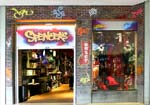 (JGA) Iconicity is Personality: Does your point of view and vision communicate a distinctive position? (Spencer’s)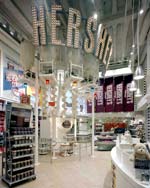 (Laszlo Regos) Iconicity is Originality: Is the character of the space authentic to the brand? (Hershey’s Chicago)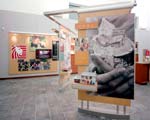 (Laszlo Regos) Iconicity is Community: Do touch-points convey a caring attitude toward the consumer? (Harris)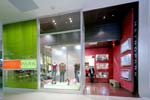 (Laszlo Regos) Iconicity is Ingenuity: Does the environment exude personal expression and originality? (Metropark)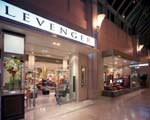 (Laszlo Regos) Iconicity is Clarity: Is the brand in focus? (Levenger)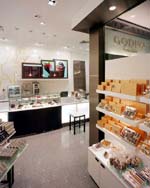 (Laszlo Regos) Iconicity is Simplicity: What type of first impression does the environment make? (Godiva Chocolatier) (Robert G. Grimm Photography) Iconicity is Unity: Is the environment characteristic of the brand’s multi-channel situation? (Soft Surroundings) |
© 2006 ArchNewsNow.com